分子生物学
- 格式:pdf
- 大小:3.05 MB
- 文档页数:9
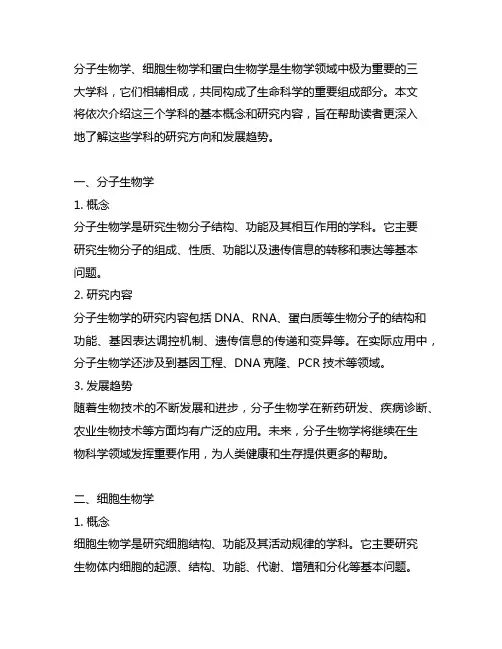
分子生物学、细胞生物学和蛋白生物学是生物学领域中极为重要的三大学科,它们相辅相成,共同构成了生命科学的重要组成部分。
本文将依次介绍这三个学科的基本概念和研究内容,旨在帮助读者更深入地了解这些学科的研究方向和发展趋势。
一、分子生物学1. 概念分子生物学是研究生物分子结构、功能及其相互作用的学科。
它主要研究生物分子的组成、性质、功能以及遗传信息的转移和表达等基本问题。
2. 研究内容分子生物学的研究内容包括DNA、RNA、蛋白质等生物分子的结构和功能、基因表达调控机制、遗传信息的传递和变异等。
在实际应用中,分子生物学还涉及到基因工程、DNA克隆、PCR技术等领域。
3. 发展趋势随着生物技术的不断发展和进步,分子生物学在新药研发、疾病诊断、农业生物技术等方面均有广泛的应用。
未来,分子生物学将继续在生物科学领域发挥重要作用,为人类健康和生存提供更多的帮助。
二、细胞生物学1. 概念细胞生物学是研究细胞结构、功能及其活动规律的学科。
它主要研究生物体内细胞的起源、结构、功能、代谢、增殖和分化等基本问题。
2. 研究内容细胞生物学的研究内容涉及细胞的形态学、生物化学、分子生物学等多个方面,主要包括细胞器的结构和功能、细胞信号传导、细胞增殖和凋亡等。
细胞生物学也与组织学、生理学等学科有着密切的关联。
3. 发展趋势细胞生物学在生物医学、生物工程、再生医学等领域有着广泛的应用,特别是在细胞治疗、干细胞技术、肿瘤治疗等方面具有重要意义。
未来,细胞生物学将继续深入研究细胞活动的机理及应用,为生物医学领域的发展做出更多贡献。
三、蛋白生物学1. 概念蛋白生物学是研究蛋白质结构、功能及其在生命活动中作用的学科。
它主要研究蛋白质的合成、折叠、修饰以及与其他生物分子的相互作用等基本问题。
2. 研究内容蛋白生物学的研究内容包括蛋白质的结构与功能关系、蛋白质质量控制、蛋白质在细胞内外的运输和定位等。
蛋白生物学还涉及蛋白质工程、蛋白质药物研发等应用领域。
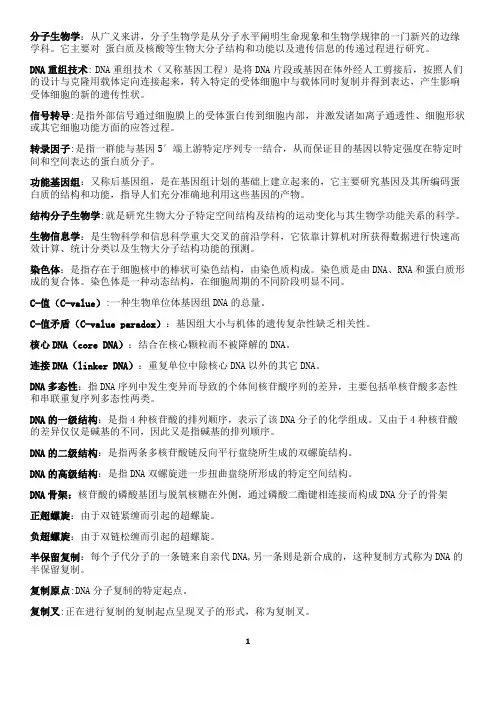
分子生物学:从广义来讲,分子生物学是从分子水平阐明生命现象和生物学规律的一门新兴的边缘学科。
它主要对蛋白质及核酸等生物大分子结构和功能以及遗传信息的传递过程进行研究。
DNA重组技术:DNA重组技术(又称基因工程)是将DNA片段或基因在体外经人工剪接后,按照人们的设计与克隆用载体定向连接起来,转入特定的受体细胞中与载体同时复制并得到表达,产生影响受体细胞的新的遗传性状。
信号转导:是指外部信号通过细胞膜上的受体蛋白传到细胞内部,并激发诸如离子通透性、细胞形状或其它细胞功能方面的应答过程。
转录因子:是指一群能与基因5′端上游特定序列专一结合,从而保证目的基因以特定强度在特定时间和空间表达的蛋白质分子。
功能基因组:又称后基因组,是在基因组计划的基础上建立起来的,它主要研究基因及其所编码蛋白质的结构和功能,指导人们充分准确地利用这些基因的产物。
结构分子生物学:就是研究生物大分子特定空间结构及结构的运动变化与其生物学功能关系的科学。
生物信息学:是生物科学和信息科学重大交叉的前沿学科,它依靠计算机对所获得数据进行快速高效计算、统计分类以及生物大分子结构功能的预测。
染色体:是指存在于细胞核中的棒状可染色结构,由染色质构成。
染色质是由DNA、RNA和蛋白质形成的复合体。
染色体是一种动态结构,在细胞周期的不同阶段明显不同。
C-值(C-value):一种生物单位体基因组DNA的总量。
C-值矛盾(C-value paradox):基因组大小与机体的遗传复杂性缺乏相关性。
核心DNA(core DNA):结合在核心颗粒而不被降解的DNA。
连接DNA(linker DNA):重复单位中除核心DNA以外的其它DNA。
DNA多态性:指DNA序列中发生变异而导致的个体间核苷酸序列的差异,主要包括单核苷酸多态性和串联重复序列多态性两类。
DNA的一级结构:是指4种核苷酸的排列顺序,表示了该DNA分子的化学组成。
又由于4种核苷酸的差异仅仅是碱基的不同,因此又是指碱基的排列顺序。
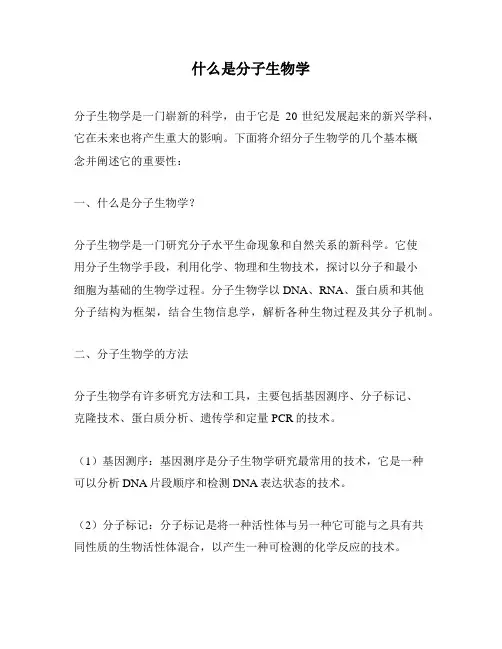
什么是分子生物学分子生物学是一门崭新的科学,由于它是20世纪发展起来的新兴学科,它在未来也将产生重大的影响。
下面将介绍分子生物学的几个基本概念并阐述它的重要性:一、什么是分子生物学?分子生物学是一门研究分子水平生命现象和自然关系的新科学。
它使用分子生物学手段,利用化学、物理和生物技术,探讨以分子和最小细胞为基础的生物学过程。
分子生物学以DNA、RNA、蛋白质和其他分子结构为框架,结合生物信息学,解析各种生物过程及其分子机制。
二、分子生物学的方法分子生物学有许多研究方法和工具,主要包括基因测序、分子标记、克隆技术、蛋白质分析、遗传学和定量PCR的技术。
(1)基因测序:基因测序是分子生物学研究最常用的技术,它是一种可以分析DNA片段顺序和检测DNA表达状态的技术。
(2)分子标记:分子标记是将一种活性体与另一种它可能与之具有共同性质的生物活性体混合,以产生一种可检测的化学反应的技术。
(3)克隆技术:克隆技术是指利用可重组DNA技术在一个宿主上复制目标DNA片段、克隆它们作为载体的技术。
(4)蛋白质分析:蛋白质分析是指利用紫外分光光度计、流式细胞仪等分析仪器,研究蛋白质结构、凝胶电泳分析、质谱分析以及免疫学方法等技术来检测蛋白质结构和性质的方法。
(5)遗传学:遗传学是指研究基因在细胞中的表达、基因间相互作用及其在不同生物间的进化变异,以及它们在适应性演化中的作用的学科。
(6)定量PCR:定量PCR是指使用定量PCR技术研究DNA序列,利用荧光基因特异性引物和特异序列来检测、建库和定量分析DNA。
三、分子生物学的重要性(1)分子生物学能够探究生命的奥秘;(2)通过分子生物学,我们可以更好地了解遗传基因是如何影响人类生理和心理行为;(3)分子生物学可以帮助我们更好地理解疾病的发展机制,进行疾病的预防和治疗;(4)分子生物学也是真核细胞和原核细胞的比较研究的基础,从而有助于我们更好地利用微生物培养;(5)分子生物学还可以帮助我们更好地利用基因工程技术实现转基因动物生物学研究和创新生物材料研究。
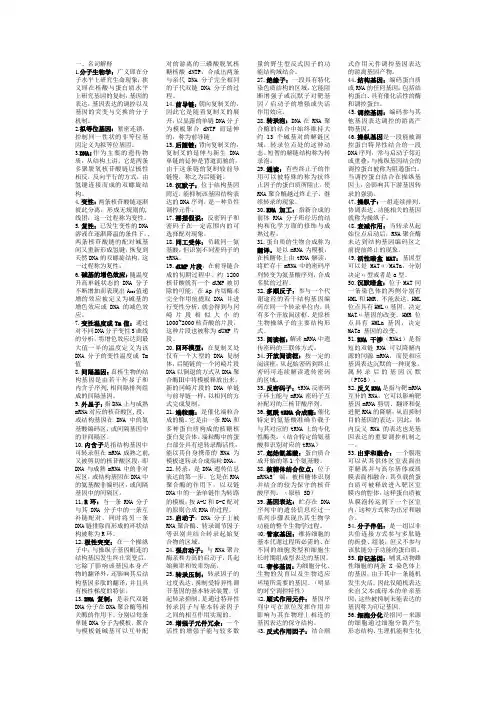
一、名词解释1.分子生物学:广义即在分子水平上研究生命现象;狭义即在核酸与蛋白质水平上研究基因的复制,基因的表达,基因表达的调控以及基因的突变与交换的分子机制。
2.拟等位基因:紧密连锁,控制同一性状的非等位基因定义为拟等位基因。
3.DNA:作为主要的遗传物质,从结构上讲,它是两条多聚脱氧核苷酸链以极性相反,反向平行的方式,由氢键连接而成的双螺旋结构。
4.变性:两条核苷酸链逐渐彼此分离,形成无规则的,线团,这一过程称为变性。
5.复性:已发生变性的DNA 溶液在逐渐降温的条件下,,两条核苷酸链的配对碱基间又重新形成氢键,恢复到天然DNA的双螺旋结构,这一过程称为复性。
6.碱基的增色效应:随温度升高单链状态的DNA分子不断增加而表现出A260值递增的效应被定义为碱基的增色效应或DNA的减色效应。
7.变性温度或Tm值:通过对不同DNA分子变性S曲线的分析,将增色效应达到最大值一半的温度定义为该DNA分子的变性温度或Tm 值8.间隔基因:真核生物的结构基因是由若干外显子和内含子序列,相间隔排列组成的间隔基因。
9.外显子:指DNA上与成熟mRNA对应的核苷酸区,段,或结构基因在DNA中的氨基酸编码区,或间隔基因中的非间隔区。
10.内含子是指结构基因中可转录但在mRNA成熟之前,又被剪切的核苷酸区段,即DNA与成熟mRNA中的非对应区,或结构基因在DNA中的氨基酸非编码区,或间隔基因中的间隔区。
11.R环:当一条RNA分子与其DNA分子中的一条互补链配对,同时将另一条DNA链排除而形成的环状结构被称为R环。
12.极性突变:在一个操纵子中,与操纵子基因毗连的结构基因发生终止突变后,它除了影响该基因本身产物的翻译外,还影响其后结构基因多肽的翻译,并且具有极性梯度的特征。
13.DNA复制:是亲代双链DNA分子在DNA聚合酶等相关酶的作用下,分别以每条单链DNA分子为模板,聚合与模板链碱基可以互补配对的游离的三磷酸脱氧核糖核酸dNTP,合成出两条与亲代DNA分子完全相同的子代双链DNA分子的过程。
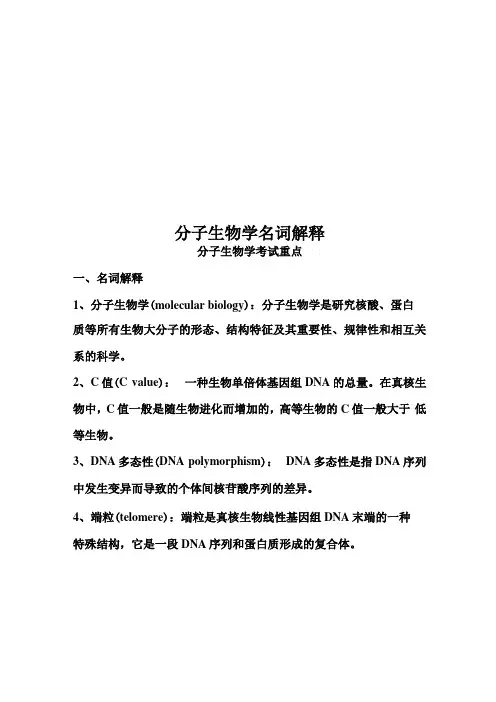
分子生物学名词解释分子生物学考试重点一、名词解释1、分子生物学(molecular biology):分子生物学是研究核酸、蛋白质等所有生物大分子的形态、结构特征及其重要性、规律性和相互关系的科学。
2、C值(C value):一种生物单倍体基因组DNA的总量。
在真核生物中,C值一般是随生物进化而增加的,高等生物的C值一般大于低等生物。
3、DNA多态性(DNA polymorphism):DNA多态性是指DNA序列中发生变异而导致的个体间核苷酸序列的差异。
4、端粒(telomere):端粒是真核生物线性基因组DNA末端的一种特殊结构,它是一段DNA序列和蛋白质形成的复合体。
5、半保留复制(semi-conservative replication):DNA 在复制过程中碱基间的氢键首先断裂,双螺旋解旋并被分开,每条链分别作为模板合成新链,产生互补的两条链。
这样形成的两个DNA分子与原来DNA 分子的碱基顺序完全一样。
一次,每个子代分子的一条链来自亲代DNA,另一条链则是新合成的,所以这种复制方式被称为DNA 的半保留复制。
6、复制子(replicon):复制子是指生物体的复制单位。
一个复制子只含一个复制起点。
7、半不连续复制(semi-discontinuous replication):DNA 复制过程中,一条链的合成是连续的,另一条链的合成是中断的、不连续的,因此称为半不连续复制。
8、前导链(leading strand):与复制叉移动的方向一致,通过连续的5W聚合合成的新的DNA链。
9、后随链(lagging strand):与复制叉移动的方向相反,通过不连续的5\T聚合合成的新的DNA链。
10、AP位点(AP site):所有细胞中都带有不同类型、能识别受损核酸位点的糖昔水解酶,它能特异性切除受损核昔酸上N-B糖昔键,在DNA链上形成去嘌吟或去嘧啶位点,统称为AP位点。
11、cDNA(complementary DNA):在体外以mRNA 为模板,利用反转录酶和DNA聚合酶合成的一段双链DNA。
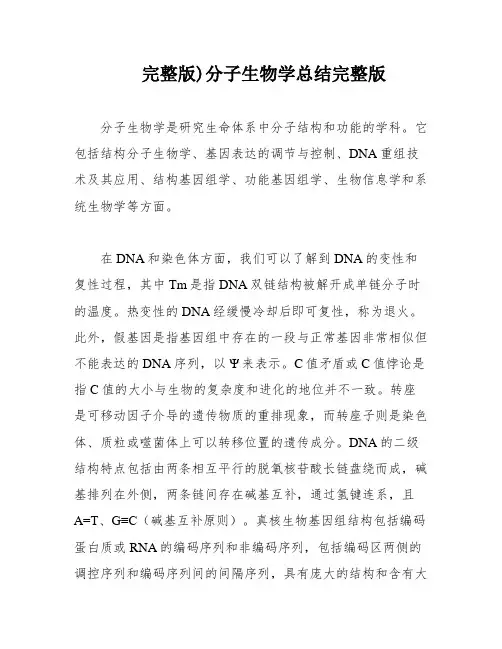
完整版)分子生物学总结完整版分子生物学是研究生命体系中分子结构和功能的学科。
它包括结构分子生物学、基因表达的调节与控制、DNA重组技术及其应用、结构基因组学、功能基因组学、生物信息学和系统生物学等方面。
在DNA和染色体方面,我们可以了解到DNA的变性和复性过程,其中Tm是指DNA双链结构被解开成单链分子时的温度。
热变性的DNA经缓慢冷却后即可复性,称为退火。
此外,假基因是指基因组中存在的一段与正常基因非常相似但不能表达的DNA序列,以Ψ来表示。
C值矛盾或C值悖论是指C值的大小与生物的复杂度和进化的地位并不一致。
转座是可移动因子介导的遗传物质的重排现象,而转座子则是染色体、质粒或噬菌体上可以转移位置的遗传成分。
DNA的二级结构特点包括由两条相互平行的脱氧核苷酸长链盘绕而成,碱基排列在外侧,两条链间存在碱基互补,通过氢键连系,且A=T、G≡C(碱基互补原则)。
真核生物基因组结构包括编码蛋白质或RNA的编码序列和非编码序列,包括编码区两侧的调控序列和编码序列间的间隔序列,具有庞大的结构和含有大量重复序列。
Histon(组蛋白)具有极端保守性、无组织特异性、氨基酸分布的不对称性、可修饰作用、富含Lys的H5等特点。
核小体由组蛋白和200bp DNA组成。
转座机制是一种基因组重排的方式。
在转座时,插入的转座子会位于两个重复的靶序列之间,而受体分子中的靶序列会被复制。
根据复制方式的不同,转座可以分为复制型和非复制型转座。
DNA生物合成时,采用半保留复制的方式。
这种方式下,母链DNA会解开为两股单链,各自作为模板合成与之互补的子链。
其中一股单链从亲代完整地接受过来,而另一股则是全新合成的。
这样,两个子细胞的DNA都与亲代DNA的碱基序列一致。
复制子是生物体内能够独立进行复制的单位。
在DNA复制中,有前导链和滞后链两种链。
前导链是以3'→5'方向为标准的模板链,而滞后链则是以5'→3'方向为标准的模板链。
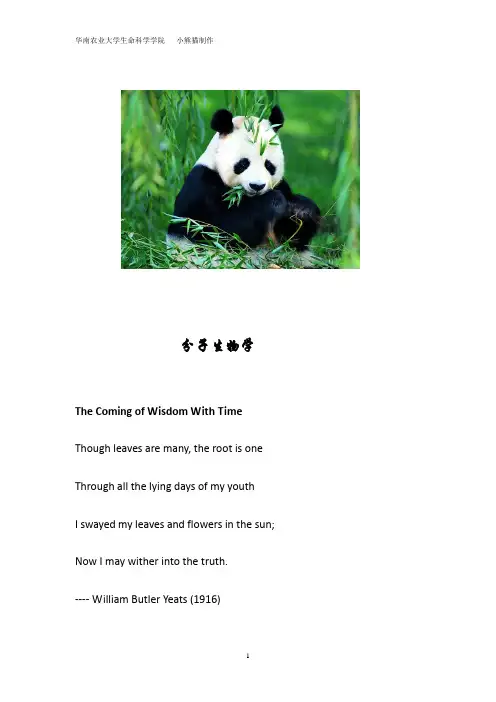
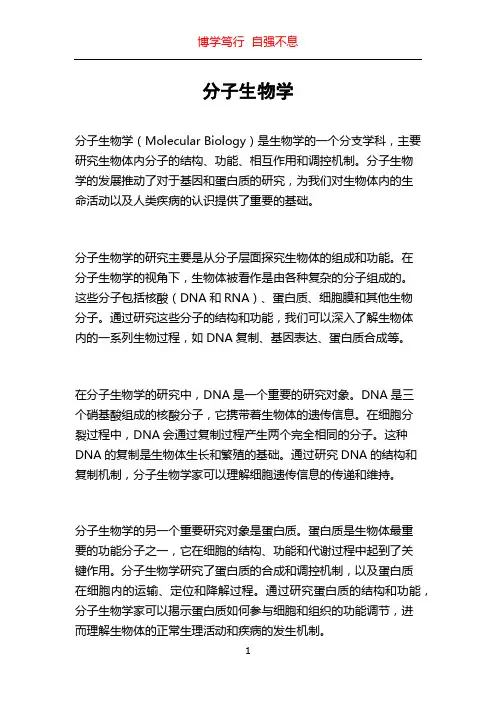
分子生物学分子生物学(Molecular Biology)是生物学的一个分支学科,主要研究生物体内分子的结构、功能、相互作用和调控机制。
分子生物学的发展推动了对于基因和蛋白质的研究,为我们对生物体内的生命活动以及人类疾病的认识提供了重要的基础。
分子生物学的研究主要是从分子层面探究生物体的组成和功能。
在分子生物学的视角下,生物体被看作是由各种复杂的分子组成的。
这些分子包括核酸(DNA和RNA)、蛋白质、细胞膜和其他生物分子。
通过研究这些分子的结构和功能,我们可以深入了解生物体内的一系列生物过程,如DNA复制、基因表达、蛋白质合成等。
在分子生物学的研究中,DNA是一个重要的研究对象。
DNA是三个硝基酸组成的核酸分子,它携带着生物体的遗传信息。
在细胞分裂过程中,DNA会通过复制过程产生两个完全相同的分子。
这种DNA的复制是生物体生长和繁殖的基础。
通过研究DNA的结构和复制机制,分子生物学家可以理解细胞遗传信息的传递和维持。
分子生物学的另一个重要研究对象是蛋白质。
蛋白质是生物体最重要的功能分子之一,它在细胞的结构、功能和代谢过程中起到了关键作用。
分子生物学研究了蛋白质的合成和调控机制,以及蛋白质在细胞内的运输、定位和降解过程。
通过研究蛋白质的结构和功能,分子生物学家可以揭示蛋白质如何参与细胞和组织的功能调节,进而理解生物体的正常生理活动和疾病的发生机制。
除了DNA和蛋白质,分子生物学还研究其他类型的分子。
例如,分子生物学研究了细胞膜的组成和运输机制,了解了细胞如何通过细胞膜与外界进行交流和物质交换。
此外,分子生物学还研究了一些小分子信号物质,如激素和信号分子,它们在细胞间的通讯和调节中扮演重要角色。
分子生物学的技术和方法也得到了快速发展。
例如,PCR(聚合酶链反应)技术可以快速复制DNA,并且已经成为了基因工程和基因诊断的关键技术。
基因测序技术则使得我们能够快速高效地获取DNA的序列信息,进一步推动了基因组学和遗传学的发展。
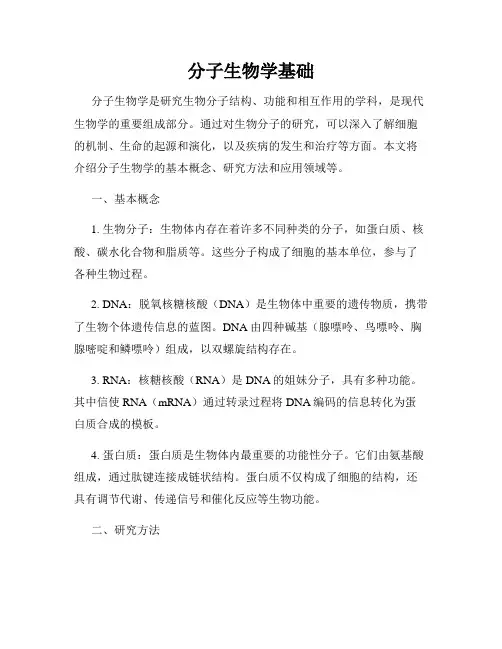
分子生物学基础分子生物学是研究生物分子结构、功能和相互作用的学科,是现代生物学的重要组成部分。
通过对生物分子的研究,可以深入了解细胞的机制、生命的起源和演化,以及疾病的发生和治疗等方面。
本文将介绍分子生物学的基本概念、研究方法和应用领域等。
一、基本概念1. 生物分子:生物体内存在着许多不同种类的分子,如蛋白质、核酸、碳水化合物和脂质等。
这些分子构成了细胞的基本单位,参与了各种生物过程。
2. DNA:脱氧核糖核酸(DNA)是生物体中重要的遗传物质,携带了生物个体遗传信息的蓝图。
DNA由四种碱基(腺嘌呤、鸟嘌呤、胸腺嘧啶和鳞嘌呤)组成,以双螺旋结构存在。
3. RNA:核糖核酸(RNA)是DNA的姐妹分子,具有多种功能。
其中信使RNA(mRNA)通过转录过程将DNA编码的信息转化为蛋白质合成的模板。
4. 蛋白质:蛋白质是生物体内最重要的功能性分子。
它们由氨基酸组成,通过肽键连接成链状结构。
蛋白质不仅构成了细胞的结构,还具有调节代谢、传递信号和催化反应等生物功能。
二、研究方法1. 分子克隆:分子克隆是指将DNA或RNA片段插入载体(如质粒)中,通过细菌或其他生物体来复制这些分子片段。
这一技术可以用于生物工程、基因治疗等领域。
2. PCR:聚合酶链反应(PCR)是一种体外扩增DNA片段的方法。
它利用特定引物和DNA聚合酶,通过一系列温度循环反复合成DNA的同源链,扩增目标序列。
3. 凝胶电泳:凝胶电泳是一种常用的分离生物分子的方法。
通过在凝胶中施加电场,根据分子的大小和电荷来分离DNA、RNA和蛋白质等。
4. 聚合酶链式反应(PCR):PCR是一种常用的体外扩增DNA片段的方法。
通过引物的特异性与DNA片段的互补性,聚合酶可以复制和扩增模板DNA。
三、应用领域1. 基因工程:分子生物学的发展为基因工程提供了基础。
通过基因重组、转基因等技术,可以克隆和改造DNA,生产重组蛋白质、植物转基因等。
2. 遗传疾病诊断:分子生物学的方法在遗传疾病的诊断中起着关键作用。

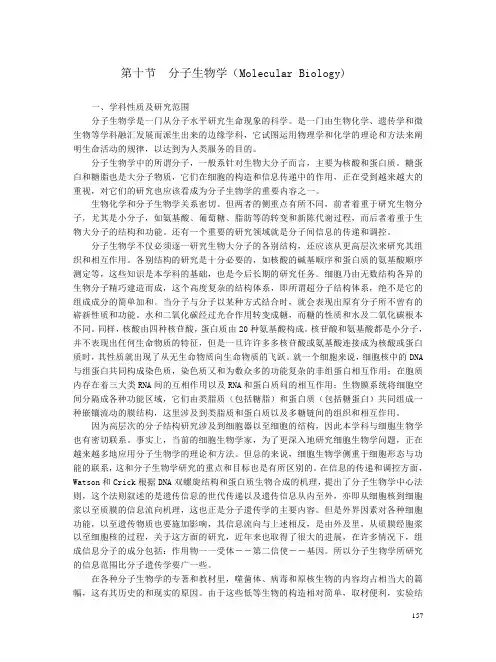
第十节分子生物学(Molecular Biology)一、学科性质及研究范围分子生物学是一门从分子水平研究生命现象的科学。
是一门由生物化学、遗传学和微生物等学科融汇发展而派生出来的边缘学科,它试图运用物理学和化学的理论和方法来阐明生命活动的规律,以达到为人类服务的目的。
分子生物学中的所谓分子,一般系针对生物大分子而言,主要为核酸和蛋白质。
糖蛋白和糖脂也是大分子物质,它们在细胞的构造和信息传递中的作用,正在受到越来越大的重视,对它们的研究也应该看成为分子生物学的重要内容之一。
生物化学和分子生物学关系密切。
但两者的侧重点有所不同,前者着重于研究生物分子,尤其是小分子,如氨基酸、葡萄糖、脂肪等的转变和新陈代谢过程,而后者着重于生物大分子的结构和功能。
还有一个重要的研究领域就是分子间信息的传递和调控。
分子生物学不仅必须逐一研究生物大分子的各别结构,还应该从更高层次来研究其组织和相互作用。
各别结构的研究是十分必要的,如核酸的碱基顺序和蛋白质的氨基酸顺序测定等,这些知识是本学科的基础,也是今后长期的研究任务。
细胞乃由无数结构各异的生物分子精巧建造而成,这个高度复杂的结构体系,即所谓超分子结构体系,绝不是它的组成成分的简单加和。
当分子与分子以某种方式结合时,就会表现出原有分子所不曾有的崭新性质和功能。
水和二氧化碳经过光合作用转变成糖,而糖的性质和水及二氧化碳根本不同。
同样,核酸由四种核苷酸,蛋白质由20种氨基酸构成。
核苷酸和氨基酸都是小分子,并不表现出任何生命物质的特征,但是一旦许许多多核苷酸或氨基酸连接成为核酸或蛋白质时,其性质就出现了从无生命物质向生命物质的飞跃。
就一个细胞来说,细胞核中的DNA 与组蛋白共同构成染色质,染色质又和为数众多的功能复杂的非组蛋白相互作用;在胞质内存在着三大类RNA间的互相作用以及RNA和蛋白质问的相互作用;生物膜系统将细胞空间分隔成各种功能区域,它们由类脂质(包括糖脂)和蛋白质(包括糖蛋白)共同组成一种嵌镶流动的膜结构,这里涉及到类脂质和蛋白质以及多糖链间的组织和相互作用。
分子生物学名词解释名词解释:1、分子生物学 (molecular biology)是从分子水平上研究生命现象、生命本质、生命活动及其规律的科学。
解释:分子一般指生物大分子(核酸和蛋白质),即以生物大分子的结构与功能为研究基础,来研究生命活动的本质与规律。
2、医学分子生物学(medical molecular biology)是分子生物学的一个重要分支,是从分子水平上研究人体和疾病相关生物在正常和疾病状态下的生命活动及其规律,从分子水平上开展人类疾病的预防、诊断和治疗研究的一门科学。
3、载体(vector ):是能携带靶DNA(目的基因)片段进入宿主细胞进行扩增或表达的DNA分子。
4、克隆载体(cloning vector):仅适于外源基因在宿主细胞中复制和扩增。
5、表达载体(expression vector):能使外源基因在宿主细胞中进行转录和翻译的载体。
6、质粒的复制子:质粒DNA中能自主复制并维持正常拷贝数的一段最小的核酸序列单位。
7、噬菌体(phage)是比细菌还小得多的微生物,和病毒侵犯真核细胞一样,噬菌体侵犯细菌,也可以认为它是细菌里的“寄生虫”。
它本身是一种核蛋白,核心是一段DNA,结构上有一个蛋白质外壳和尾巴,尾巴上的微丝可以把噬菌体的DNA注入细菌内。
8、溶菌生长:λ噬菌体感染细菌后,λDNA通过粘性末端而环化,并在宿主中多次复制,合成大量基因产物,装配成噬菌体颗粒,最后裂解宿主菌。
9、溶源生长:λDNA整合到宿主染色体基因组DNA中与之一起复制并遗传给子代,但宿主细胞不被裂解。
10、插入型载体(insertion vector):每种酶只有一个酶切位点。
如λgt系列,适用cDNA克隆。
λ噬菌体载体11、置换型载体(replacement vector ):有两组(成对)反向排列的多克隆位点,其间DNA序列可被外源基因取代。
如EMBL系列,适用基因组克隆12、穿梭载体:是一类既能在原核细胞中复制又能在真核细胞中复制表达的载体。
一、名词解释1、分子生物学(狭义):研究核酸和蛋白质等大分子的形态、结构特征及其重要性、规律性和相互关系的科学,主要研究基因的结构和功能及基因的活动。
2、分子生物学(广义):在分子的水平上研究生命现象的科学,涵盖了分子遗传学和生物化学等学科的研究内容。
3、基因:是具有特定功能、能独立发生突变和交换的、“三位一体”的、最小的遗传单位。
4、顺反子:基因的同义词,是一个具有特定功能的、完整的、不可分割的最小遗传单位。
5、增色效应:当进行DNA热变性研究时,温度升高单链状态的DNA分子不断增加而表现出A260值递增的效应。
6、变性温度:DNA双链在一定的温度下变成单链,将开始变性的温度至完全变性的温度的平均值称为DNA的变性温度。
7、DNA的复性:DNA在适当的条件下,两条互补链全部或部分恢复到天然双螺旋结构的现象。
8、C值:一种生物中其单倍体基因组的DNA总量。
9、C值悖论:C值和生物结构或组成的复杂性不一致的现象。
10、重叠基因:共有同一段DNA序列的两个或多个基因。
11、重复基因:基因组中拷贝数不止一份的基因。
12、间隔基因(断裂基因):就是基因的编码序列在DNA分子上是不连续的,为不编码的序列所隔开。
13、转座子:在基因组中可以移动的一段DNA序列。
14、转座:一个转座子从基因组的一个位置转移到另一个位置的过程。
15、假基因:基因组中存在的一段与正常基因非常相似但不能表达的DNA序列。
16:、DNA 复制:亲代双链的DNA分子在DNA聚合酶等相关酶的作用下,别以每条单链DNA为模板,聚合与模板链碱基对可以互补的游离的dNTP,合成两条与亲代DNA分子完全相同的子代双链DNA分子的过程。
17、复制子:从复制起点到复制终点的DNA区段称为一个复制子。
18、复制体:在复制叉处装备并执行复制功能的多酶复合体。
19、复制原点(复制起点):DNA分子中能独立进行复制的最小功能单位。
20、端粒:染色体末端具有的一种特殊结构,对维持染色体的稳定起着十分重要的作用。
分子生物学名词解释1、广义的分子生物学:是研究核酸、蛋白质等生物大分子的结构与功能,并从分子水平阐述蛋白质与核酸、蛋白质与蛋白质之间相互作用的关系及基因表达调控机理的学科,是人类从分子水平上真正揭开生物世界的奥秘,即从分子水平阐明生命现象和生物学规律的学科。
2、狭义的分子生物学:人们常采用狭义的概念,将分子生物学的范畴偏重于核酸的分子生物学(核酸的结构、DNA的复制、基因的转录、表达和调控),当然也涉及与这些过程相关的蛋白质和酶的结构与功能的研究。
3、蛋白质组:指的是一个基因组所表达的全部蛋白质。
蛋白质组学:是以蛋白质组为研究对象,研究细胞内所有蛋白质及其动态变化规律的科学。
4、生物信息学:对DNA和蛋白质序列资料中各种类型信息进行识别、存储、分析、模拟和传输。
5、蛋白质(protein)是由许多氨基酸(amino acids)通过肽键(peptide bond)相连形成的高分子含氮化合物。
蛋白质的化学组成:1、主要元素:C、H、O、N和S,有些蛋白质还含有少量磷和金属元素。
2、特点:各种蛋白质的含氮量很接近,平均含氮量为16%。
3、凯氏定氮法测定蛋白质含量:蛋白质含量=6.25×样品含氮量6、等电点:在某一pH的溶液中,氨基酸上的-NH2和-COOH解离成度完全相等,即氨基酸所带净电荷为零,呈电中性,此时溶液的pH值称为该氨基酸的等电点。
7、结构域( Domain):球状蛋白质的折叠单位。
相邻的超二级结构紧密联系,形成二个或多个空间上明显突出的局部区域。
它与分子整体以共价键相连,不易分离,具有不同的生物学功能。
8、电泳:带电粒子在电场中向着与其本身所带电荷相反的电极移动的过程称为电泳。
9、DNA的呼吸作用:正常情况下,DNA双螺旋结构中的氢键处于不断的断裂和重新形成的平衡状态(特别是稳定性较低的富含A-T的区段,氢键的断裂和再生更加明显),这种现象称为DNA的呼吸作用。
10、DNA的变性:DNA双链间的氢键断裂,空间结构破坏,形成单链无规线团状态的过程叫做DNA的变性,或解链。
什么是分子生物学?分子生物学是一门研究生物系统中分子结构和功能的学科。
它主要关注于生命中的基本分子、如蛋白质、核酸、糖等,以及这些分子之间的相互作用和反应。
分子生物学已成为现代生物学的重要分支之一,不仅对于解释生命现象、揭示生命本质有着重要作用,还对于药物研发以及生物技术的应用具有重要意义。
以下是分子生物学相关的细节介绍:1.分子生物学的起源分子生物学主要起源于20世纪50年代,当时科学家们开始使用分离、分析并重组生物分子来探究生命现象。
这个时期,人类首次将DNA重组到另一个生物的细胞中。
之后,随着技术的进步和研究的深入,分子生物学迅速发展成为一个独立的学科门类。
2.分子生物学的重点研究内容分子生物学的研究方向涉及到上千种生物分子的组成、功能以及相互作用。
比如,DNA 序列、基因表达、蛋白质结构和功能、酶学、免疫学等。
这些研究方向对于我们理解生物机理以及开发新的医学和生物技术有着至关重要的作用。
3.分子生物学的主要技术随着科技的发展,研究人员不断开发各种高精度、高通量的技术手段来探究分子生物学中的诸多问题。
其中,PCR 技术、DNA 测序技术、原位杂交和蛋白质免疫共沉淀等技术成果对这个领域产生了重大的影响。
4.分子生物学的应用前景研究人员经过多年的努力,已经将分子生物学应用到众多生物领域中,比如医学、生物工程、生物化学等。
例如,利用基因编辑技术对遗传病进行治疗以及生物制药等。
这些都是分子生物学研究成果的重要体现。
总之,分子生物学是生命科学的重要组成部分,它为广泛的学科提供了有力的工具和理论支持,也为开发更好的药物和改变人类命运提供了重要的思路和方法。
The CID1cyclin C-like gene is important for plant infection in Fusarium graminearumXiaoying Zhou,Christina Heyer,Yoon-E Choi,Rahim Mehrabi,Jin-Rong Xu *Department of Botany and Plant Pathology,Purdue University,West Lafayette,IN 47907,United Statesa r t i c l e i n f o Article history:Received 3May 2009Accepted 5November 2009Available online 10November 2009Keywords:MycotoxinDeoxynivalenol Pathogenicity Gibberella zeaea b s t r a c tHead blight or scab caused by Fusarium graminearum is a destructive disease of wheat and barley.The pathogen can cause severe yield losses and contaminates infested kernels with harmful mycotoxins.In this study,we characterized the CID1gene in F.graminearum that is an ortholog of the Fusarium verticil-loides FCC1and yeast UME3genes.The protein encoded by CID1has typical structural features of C-type cyclins.Deletion of CID1resulted in a reduction in conidiation and vegetative growth but an increase in pigmentation.The D cid1mutant was female sterile but could outcross as a male.It was significantly reduced in DON production and virulence on wheat heads and corn stalks.Only about 50%of inoculated spikelets developed scab symptoms and scab disease rarely extended to nearby florets,suggesting that the D cid1mutant was defective in colonizing and spreading in wheat heads.Deletion of CID1resulted in reduced expression levels of TRI5and TRI101but increased PKS12expression.When expressed in F.ver-ticillioides ,the CID1gene complemented the defects of the D fcc1mutant in conidiation,hyphal growth,and fumonisin production.Our data indicate that the CID1C-type cyclin gene plays multiple roles in the regulation of vegetative growth,sexual development,conidiation,DON production,and pathogenicity.Ó2009Elsevier Inc.All rights reserved.1.IntroductionFusarium graminearum (Schwabe)infects a broad range of crop plants including wheat,barley,and maize (Bai and Shaner,2004;Goswami and Kistler,2004).In addition to yield losses,infested cereals are often contaminated with mycotoxins,such as deoxyni-valenol (DON),that are harmful to humans and animals (Desjar-dins et al.,1996;McMullen et al.,1997).DON is a potent inhibitor of protein synthesis in eukaryotic organisms and causes a variety of acute and chronic toxicoses.Ascospores that are forc-ibly discharged from mature perithecia are the primary inoculum for the infection of flowering wheat heads in the spring (McMullen et al.,1997;Trail et al.,2005).Infection of wheat can occur from the beginning of anthesis until the dough stage of kernel develop-ment,and is initiated when ascospores or conidia are deposited on or inside flowering spikelets.The fungus penetrates through sto-mata or floral bracts (Pritsch et al.,2000).From the infected floret,the fungus can spread up and down the spike and cause severe damage.Molecular mechanisms underlying pathogenesis in F.graminea-rum are complex and not fully understood.In addition to genes re-lated to well conserved signal transduction pathways (Hou et al.,2002;Jenczmionka et al.,2003;Jenczmionka and Schafer,2005;Urban et al.,2003;Yu et al.,2008),a number of pathogenicitygenes with diverse biological or biochemical functions have been characterized (Han et al.,2007;Lee et al.,2005;Lu et al.,2003;Seong et al.,2005,2006;Shim et al.,2006).The first pathogenicity factor most thoroughly characterized by molecular studies in F.graminearum is the trichodiene synthase gene TRI5(Desjardins et al.,2000;Proctor et al.,1995).Although trichothecene mycotox-ins are not necessary for the initial infection,they are important for the spread of the fungus within colonized spikes (Bai et al.,2002;Desjardins et al.,2000;Harris et al.,1999;Proctor et al.,1995).In the past decade,the trichothecene biosynthetic gene cluster and biosynthesis pathway have been extensively studied.Most genes encoding enzymes for metabolic steps in DON biosynthesis have been characterized,including TRI3,TRI5,TRI6,TRI7,TRI10,and TRI101(Kimura et al.,2003,2007;Lee et al.,2002).TRI6and TRI10are pathway-specific transcription factors for the TRI genes (Hohn et al.,1999;Seong et al.,2009;Tag et al.,2001).However,global regulatory systems that control the expression of TRI genes and DON synthesis in F.graminearum are not well characterized.In F.verticilloides ,a close relative of F.graminearum ,the FCC1C-type cyclin-like gene was identified by random insertional muta-genesis to be important for fumonisin biosynthesis (Shim and Woloshuk,2001).On corn kernels and defined minimal medium at pH 6,the fcc1deletion mutant was reduced in conidiation and blocked in fumonisin production.Further studies indicated that the Fck1cyclin-dependent kinase directly interacts with Fcc1.Deletion of FCK1also lead to a significant reduction in conidiation and fumonisin production on corn kernels (Bluhm and Woloshuk,1087-1845/$-see front matter Ó2009Elsevier Inc.All rights reserved.doi:10.1016/j.fgb.2009.11.001*Corresponding author.Fax:+17654960363.E-mail address:jinrong@ (J.-R.Xu).Fungal Genetics and Biology 47(2010)143–151Contents lists available at ScienceDirectFungal Genetics and Biologyjournal homepage:www.else v i e r.c o m /l o c a t e /y f g bi2006).The Fcc1-Fck1system appears to play an important regula-tory role in conidiation and mycotoxin biosynthesis in F.verticillio-ides.A number of genes that are likely regulated by Fcc1have been identified,including FZR1that encodes a zincfinger transcription factor(Flaherty and Woloshuk,2004;Pirttila et al.,2004).In this study initiated by a summer research student,we iden-tified the F.verticilloides Fcc1ortholog in F.graminearum named CID1(for Cyclin C-like gene required for infection and DON produc-tion1).Deletion of CID1resulted in a reduction in conidiation but an increase in pigmentation.The D cid1mutant was reduced in vegetative growth and DON production.It was defective in spread-ing in wheat heads and nearly non-pathogenic.When expressed in F.verticillioides,the CID1gene complemented the defects of the D fcc1mutant in conidiation,hyphal growth,and fumonisin pro-duction.Our data indicate that this well-conserved cyclin C-and cyclin-dependent kinase system is involved in the regulation of trichothecene synthesis and plant infection processes in F. graminearum.2.Materials and methods2.1.Fungal strains and growth conditionsThe Fusarium graminearum wide type strain PH-1and transfor-mants generated in this study were routinely maintained at25°C on V8juice agar and incubated in liquid CMC medium for conidium production as described(Hou et al.,2002;Trail et al.,2003).To as-say the effects of pH on conidiation,the CMC medium was adjusted to pH3.0,5.0,7.0,and9.0with phosphoric acid as described(Shim and Woloshuk,2001).Conidia were collected byfiltration through two layers of Miracloth(Calbiochem,La Jolla,CA)and counted with a hemacytometer(Hou et al.,2002).Protoplast preparation and fungal transformation were performed as described(Proctor et al.,1995).TB3medium(0.3%yeast extract,0.3%casamino acids, and20%sucrose)supplemented with200l g/ml hygromycin B (Calbiochem)or200l g/ml G418(Sigma,St.Louis,MO)was used for selection of transformants(Seong et al.,2006).Growth rate on V8juice agar was assayed with race tube cultures incubated at25°C for16days.For assaying defects of the D cid1mutant in stress responses,cultures grown on YEPD medium(0.3%yeast ex-tract,1%peptone,2%glucose,1.8%g agar)with different concen-trations of NiCl2,CdCl2,and H2O2was measured for colony radius after incubation for7days.Selfing and outcrossing with the nit1mutant11622were performed on carrot agar plates (Hou et al.,2002).DON and ergosterol production in infected wheat kernels were measured as previously described(Bluhm and Woloshuk,2005;Bluhm and Woloshuk,2006;Goswami and Kistler,2005).To assay the effect of acidic pH on DON production, the defined medium containing0.2%agmatine(Gardiner et al., 2009a)was buffered with phosphoric acid to different pH values as described(Shim and Woloshuk,2001).Culture conditions for DON production followed what were described by Gardiner and colleagues(2009a,b).For F.verticillioides,the wild-type strain FT536,the D fcc1mu-tant(Shim and Woloshuk,2001),and the D fcc1/CID1comple-mented strain were cultured on V8juice agar for assaying vegetative growth.For conidium production, F.verticillioides strains were grown in the BSAL6.0medium(Shim et al.,2006)at 25°C.2.2.The CID1gene replacement vector and mutantA0.7-kb upstream sequence and a0.8-kb downstreamflanking sequence of the CID1gene were amplified with primer pairs CID1-F1/CID1-R2and CID1-F3/CID1-R4(Table4),respectively.Primers HYGF,HYR,YGF,and HYGR(Table4)were used to amplify PCR fragments for generating the D cid1deletion construct by the split-marker approach(Catlett et al.,2003).After fungal transfor-mation,hygromycin-resistant transformants were screened by PCR with primers CID1-F5and CID1-R6(Table4).The putative D cid1mutant was further confirmed by Southern blot analysis fol-lowing standard molecular protocols(Sambrook and Russell, 2001).Genomic DNA was digested with Xho I and separated on 0.8%agarose gel before being transferred to a nylon membrane.For complementation assays,a3.4-kb fragment containing the entire CID1gene,including the open reading frame,1.7-kb pro-moter region,and0.6-kb terminator region,was amplified with primers CID1-CF and CID1-CR(Table4)and cloned between the Bam HI and Not I sites of pHZ100(Bluhm et al.,2007)to generate the complementation construct pCID1.In pHZ100,the neomycin-resistant cassette derived from pSM334was inserted into the vec-tor backbone.Plasmid pCID1was transformed into the D cid1mu-tant CH1as described(Proctor et al.,1995).2.3.Corn stalk and wheat infection assaysConidia were collected from5-day-old CMC cultures byfiltra-tion through two layers of Miracloth(Calbiochem)and resus-pended to5Â104conidia/ml in sterile distilled water.For infection assays with corn plants of cultivar Pioneer2375,sterile wooden toothpicks were briefly dipped in the spore suspension and then slowly droved into the stalk between the tassel and node immediate below.Stalk rot symptoms were examined14days-post-inoculation(dpi)by removing the toothpick and slicing corn stalks into halves along the inoculation sites.Six-week-old plants of wheat cultivar Norm were used for inoculation as described (Gale et al.,2002;Kang and Buchenauer,1999).The second,full-sized spikelet from the base of the inflorescence was injected with 10l l of the spore suspension.Inoculated wheat heads were cov-ered with a small plastic bag for2days.Infected plants were then cultured at ambient greenhouse conditions.Symptomatic spikelets in each head were counted14dpi to calculate the disease index as described(Gale et al.,2002;Seong et al.,2006).At least nine inoc-ulated wheat heads per treatment were used for each test and all tests were repeated four times.Diseased kernels were harvested from inoculated spikelets and assayed for DON and ergosterol as described(Bluhm et al.,2007).2.4.Quantitative RT-PCR(qRT-PCR)A total of108conidia of each strain was inoculated into100ml of YEPD medium and incubated at25°C for48h with shaking at 150rpm.Mycelia were harvested byfiltration through two layers of Miracloth.RNA was isolated from mycelia with the Trizol re-agent(Invitrogen,Carlsbad,CA).The StrataScript QPCR cDNA syn-thesis kit(Stratagene,La Jolla,CA)was used for cDNA synthesis following the instruction provided by the manufacturer.The pri-mer pairs used for qRT-PCR were Tri5QF/TRI5QR for TRI5, PKS12QF/PKS12QR for PKS12(Table4),TubQF/TubQR(Bluhm et al.,2007)for the beta-tubulin gene TUB2.PCR was performed with a MX3000(Stratagene)System with the program of2min at50°C,10min at95°C,and40cycles of15s at95°C followed by1min at60°C.Data were collected with the sequence detector software MXPro.All expression data were normalized to TUB2 expression and relative changes in gene expression levels were cal-culated by the comparative Ct method(Applied Biosystems,Foster City,CA).For each gene assayed by qRT-PCR,data from three bio-logical replicates were used to calculate the mean and standard deviation.144X.Zhou et al./Fungal Genetics and Biology47(2010)143–151plementation of the F.verticilloides D fcc1mutant with the CID1genePlasmid pCID1containing the full length CID1gene was trans-formed into the F.verticillioides D fcc1mutant FT536as described (Shim and Woloshuk,2001).Neomycin-resistant transformants were isolated and verified by PCR with primers CID-5F and CID-6R to contain the CID1gene integrated in the F.verticillioides gen-ome.Cracked corn cultures incubated at 25°C for 14days were used for assaying fumonisin B1(FB1)production as described (Shim and Woloshuk,2001).3.Results3.1.The CID1gene is well conserved in filamentous ascomycetes BLASTP search revealed that the homolog of the F.verticilloides FCC1gene in F.graminearum is FGSG_04355.3,which was namedthe CID1gene (for Cyclin C-like gene required for infection and DON production 1)in this study.CID1also is homologous to UME3of Saccharomyces cerevisiae that encodes a C-type cyclin or cyclin C-like protein.Ume3p is one component of the RNA polymerase II holoenzyme,and it is required for the repression of genes involved in meiosis and stress response (Kuchin et al.,1995).The CID1gene is predicted to encode a 321amino acid peptide.Like Ume3and Fcc1,the Cid1protein had the cyclin box for cyclin-CDK interactions and the holoenzyme associating domain (Fig.1A).It also contains the PEST-rich region and RQLK motif that are known to be responsible for Ume3degradation in S.cerevisiae (Cooper et al.,1997).Cid1protein is 85%identical to Fcc1and its ortholog from F.oxysporum (FOXG_13879).All these Fusarium cy-clin C-like proteins are highly conserved in the cyclin box and the cyclin destruction domains.3.2.The D cid1mutant is defective in hyphal growth and conidiation To determine the function of CID1in F.graminearum ,we gen-erated mutants in which the CID1gene was deleted with the split-marker approach (Catlett et al.,2003)(Fig.1B).After trans-formation of wild-type PH-1protoplasts,hygromycin-resistant transformants were isolated and screened by PCR with primers CID-F5and CID-R6(Fig.1B).One D cid1mutant named CH1was identified and further confirmed by Southern blot analysis (Fig.1C).When hybridized with the downstream flanking frag-ment amplified with primers F3and F4(probe 1),a 1.5kb band was detected in PH-1.The D cid1mutant had a 7.0kb band that was diagnostic for the gene replacement event.When hybridized with the CID1ORF region amplified with primers F5and R6(probe 2),the 1.5kb band detected in PH-1was absent in the D cid1mutant (Fig.1C).The growth rate of the D cid1mutant was measured with race tube cultures grown at 25°C for 16days.On average,it grew about 30%slower than the wild-type strain (Table 1).The mutant also was reduced about 50%in conidiation (Table 1).Conidia produced by the D cid1mutant had only four cells (three septa)instead of 5–6celled wild-type conidia (Fig.2A).Some of them also lacked the typical morphology of Fusarium conidia.In addition,conidium ger-mination was slightly delayed in the mutant but germ growth and hyphal branching appeared to be normal (Fig.2A).The D cid1mu-tant had increased pigmentation in aerial hyphae of aging cultures.Five-day-old V8agar cultures of the mutant appeared to be more reddish than those of the wild-type strain (Fig.2B).To confirm that deletion of CID1was responsible for observed defects in vegetative growth and conidiation,we transformed the full-length wild-type CID1allele into the D cid1mutant CH1.The resulting transformant CH1comp (D cid1/CID1)had the wild-type growth rate and was normal in conidiation (Table 1),indicating that the defects of the mutant were complemented by the ectopic copy of the CID1gene.Fig.1.The CID1gene and generation of the D cid1mutant.(A)CID1encodes a typical cyclin C-like protein.Filled box,cyclin domain;empty box,the ROLK motif;hatched box,PEST-rich region.(B)The split-marker approach was used to replace the entire CID1gene with the hygromycin resistance cassette.Probe 1and probe 2are PCR products amplified with primers F3/R4and F5/R6,respectively.X:Xho I.(C)Southern blot analysis with Xho I-digested geonomic DNA of PH-1and the D cid1mutant.Two different blots were hybridized with probe 1(left)and probe 2(right).Table 1Vegetative growth,conidiation,and DON production in Fusarium graminearum strains.StrainsGrowth rate a (mm/day)Conidiation b (5Â104/ml)DON c (ppm)Erg c (ppm)DON/Erg ratio PH-112.5±0.3A *133.0±0.6A 318.4±1.2103.4±2.1 3.01A CH1(D cid1)9.2±0.2D 67.0±0.6D 20.5±0.691.5±2.00.25H CH1comp (D cid1/CID1)12.5±0.5A132.0±0.6A290.5±2.397.9±2.12.99AaGrowth rate was measured with race tube cultures (V8juice agar)after incubating at 25°C for 16days.Means and standard errors were calculated from six replicates for each strain.bConidiation was assayed with 5-day-old CMC cultures as described (Hou et al.,2002).cDON and ergosterol (Erg)was assayed with the wheat kernels that were harvested from the inoculated florets 14dpi.*The same letter indicated that there was no significant difference.Different letters were used to mark statistically significant difference (P =0.05).X.Zhou et al./Fungal Genetics and Biology 47(2010)143–1511453.3.CID1is essential for female fertilityF.graminearum is a homothallic fungus but it can be forced to outcross.On selfing carrot agar plates,the D cid1mutant failed to form perithecia (Fig.2B).Close examination indicated that the mu-tant was blocked in the differentiation of protoperithecia.Although it was female sterile,the D cid1mutant was able to mate as the male.When mating with a nit1mutant,D cid1nit1recombinant progeny were isolated from outcross perithecia.The comple-mented transformant CH1comp (D cid1/CID1)produced fertile peri-thecia on selfing plates (Fig.2C),further indicating that CID1is essential for female fertility in F.graminearum.Fig.2.Defects of the D cid1mutant in conidium morphology,colony pigmentation,and mating.(A)Conidia of the wild-type PH-1,D cid1mutant,and D cid1/CID1complemented (comp)strains were examined after incubation in liquid CM for indicated times.Bar =10l m.(B)Colonies of PH-1,D cid1mutant,and comp strains grown on V8agar for 5days.(C)Selfing plates of PH-1,D cid1mutant,and D cid1/CID1complemented strain.Black dots on the surface were perithecia.146X.Zhou et al./Fungal Genetics and Biology 47(2010)143–1513.4.The D cid1mutant is defective in colonizing flowering wheat heads To determine the function of CID1in plant infection,flowering wheat heads were point-inoculated with conidium suspensions.On wheat heads inoculated with the wild-type strain,typical scab symptoms were observed in the inoculated and nearby spikelets 14days post-inoculation (dpi).Under the same conditions,only about 50%of the spikelets inoculated with D cid1conidia developed scab symptoms.On heads with disease symptoms caused by the D cid1mutant,wheat scab was limited to the inoculated spikelets (Fig.3A).Spikelets nearby the inoculation site remained healthy 14dpi.On average,the D cid1mutant had a disease index score of 0.5(Fig.3B).In comparison with the disease index of the wild-type strain,the mutant had a 16-fold reduction in virulence.Re-introduction the wild-type CID1gene complemented the defects of the D cid1mutant.In wheat head infection assays,the D cid1/CID1complemented strain was as virulent as PH-1(Fig.3).These data indicated that CID1is important for full virulence on wheat.3.5.The CID1gene also is important for full virulence on maize F.graminearum is also a corn stalk rot pathogen.In corn plants inoculated with the D cid1mutant,stalk rot symptoms were ob-served at the inoculation site (Fig.4).When measured at 14dpi,the average length of stalk rot lesions caused by the D cid1mutant was 1.6±0.2cm.Under the same conditions,the length of stalk rotlesions were 6.3±0.5cm and 6.3±0.7cm (Table 1),respectively,for the wild-type and complemented strains.Therefore,the D cid1mutant had a 75%reduction in virulence on corn stalks.These re-sults suggest that the CID1gene might be important for F.grami-nearum to colonize and spread in the corn pith.3.6.The D cid1mutant is defective in stress responsesIn yeast,the ume3mutant has increased sensitivities to various stresses (Cohen et al.,2003;Cooper et al.,1997).To test whether the D cid1mutant had similar defects,Ni 2+,Cd 2+,and H 2O 2were added to YEPD medium (Table 2).In the presence of 500l m Ni 2+,the growth rate of the mutant was about 30%of that of the wild-type strain.Colony growth was completely inhibited by 1mM Ni 2+in the D cid1mutant,but the wild-type strain (PH-1)still grew under the same conditions (Table 2).The D cid1mutant also was more sensitive to the CdCl 2and H 2O 2treatments than the wild-type strain.In the presence of 100l m Cd2+or 0.04%H 2O 2,it grew about 50%slower than the wild-type strain (Table 2).The D cid1mutant,but not the wild-type strain,failed to grow on med-ium with 500l m Ni 2+or 1%H 2O 2.These results suggest that the CID1gene may be important for responses to oxidative and heavy metal stresses.3.7.DON production and TRI5expression are reduced in the D cid1mutantTo determine the role of CID1in DON production,we isolated the diseased wheat kernels from the inoculated spikelets and mea-sured DON content.On average,only about 20ppm DON (Table 1)was detected in wheat kernels infected by the D cid1mutant.Ker-nels inoculated with the wild-type and complemented strains con-tained approximately 300ppm DON.Because the D cid1mutant was reduced in growth rate,the same samples also wereassayedFig.3.The D cid1mutant was defective in disease spread in wheat heads.(A)Infection assays with flowering wheat heads.Typical heads were photographed 14dpi.The spikelets inoculated with PH-1,D cid1mutant CH1,D cid1/CID1strain CH1comp and water are marked with arrows.(B)Disease index of PH-1,D cid1mutant CH1,and D cid1/CID1complemented strain CH1comp.Mean and standard error were calculated from four independent infectionassays.Fig.4.Infection assays with corn stalks.Toothpicks carrying fungal spores were used to inoculate corn plants between the first node and tassel.Stalk rot symptoms were examined 14dpi.The inoculation sites are marked with an arrow.X.Zhou et al./Fungal Genetics and Biology 47(2010)143–151147for ergosterol for a measure of fungal biomass.After normalization with ergosterol,it was clear that DON production was significantly reduced by deletion of the CID1gene (Fig.5A).The DON/ergosterolratio in wheat kernels colonized by the D cid1mutant was about nine times less than that of the wild-type and complemented transformant (Fig.5A),indicating that CID1plays an important role in regulating DON synthesis in wheat kernels.To further support the conclusion that the CID1gene affects DON synthesis,we assayed the expression of the trichodiene syn-thase gene TRI5by quantitative RT-PCR (qRT-PCR).RNA samples were isolated from hyphae grown in YEPD medium for 2–3days.In the D cid1mutant,the expression level of TRI5was reduced about four times in comparison with that of the wild-type or com-plemented strain (Fig 5B).We also assayed the expression of the TRI101gene that encodes a trichothecene acetyltransferase.The expression level of TRI101was reduced in the D cid1mutant but to a lesser extent than that of TRI5(Fig.5B).Because of increased pigmentation in the mutant deleted for CID1,we also assayed the expression levels of two polyketide syn-thase genes,PKS12and PKS10.In comparison with the wild type,the expression level of PKS12,which is responsible for aurofusarin synthesis in F.graminearum was increased about three times in the D cid1mutant (Kim et al.,2005;Malz et al.,2005).Expression of PKS12in the complemented transformant was comparable to the wild-type level (Fig.6B).In contrast,PKS10was expressed at sim-ilar levels in all these three strains assayed (Fig.6B).These results indicated that deletion of CID1had different effects on the expres-sion of different PKS genes.Increased expression of PKS12might result in increased production of aurofusarin and contribute to en-hanced pigmentation observed in the D cid1mutant.3.8.Acidic pH failed to suppress the defects of the D cid1mutant in conidiation and toxin productionBecause acidic pH has a significant impact on conidiation and fumonisin synthesis in F.verticillioides (Shim and Woloshuk,Table 2Differences between the wild-type and D cid1mutant in stress responses.TreatmentsConcentrationReduction in the growth rate (%)*PH-1D cid1mutant Ni 2+(l M)10015.6±3.117.4±1.225019.7±2.920.4±1.350033.2±2.166.5±1.8100079.4±1.0100Cd 2+(l M)103±2.923.0±2.710031.5±0.960.9±3.025068.5±2.282.6±1.150084.4±0.8100H 2O 2(%)0.0112.6±2.327.4±1.00.0439.1±3.162.2±0.30.0850.9±1.997.0±0.10.1061.2±0.9100*The radius of colonies was measured after incubating at 25°C for 7days.Reduction in the growth rate was estimated by comparing colonial growth on medium with each treatment with that of PH-1and the D cid1mutant on regular YPEG medium.Means and standard deviation were calculated from threereplicates.Fig.5.DON production and TRI5expression.(A)The DON/ergosterol ratio in wheat kernels infected with PH-1,D cid1mutant,and D cid1/CID1complemented strain.Ergosterol was measured as the estimate for fungal biomass.DON production was reduced in the D cid1mutant.(B)The expression levels of TRI5and TRI101were measured by real-time qRT-PCR.After being normalized to TUB2expression,their relative expression levels in the D cid1mutant were presented as fold changes in comparison with those of the wild-type strain (artificially set to 1).Mean and standard deviation were calculated with data from three biologicalreplicates.Fig.6.Pigmentation and PKS12expression.(A)Liquid cultures of the wild-type and D cid1mutant strains.Enhanced pigmentation was observed in the D cid1mutant after incubation in CMC medium for 5days.(B)The relative quantity of the PKS10and PKS12transcripts was compared between the wild-type strain (arbitrarily set to 1)and the D cid mutant.Mean and standard deviation were calculated with data from three replicates.The expression level of PKS12,but not PKS10,was increased in the D cid mutant.148X.Zhou et al./Fungal Genetics and Biology 47(2010)143–1512001),we also assayed conidiation and DON production in D cid1 cultures buffered at different pH.In F.graminearum,acidic pH ap-peared to have an inhibitory effect on conidiation(Table3).Both the wild-type and D cid1mutant strains produced fewer conidia at pH5than at pH7.At pH3,conidiation was completely blocked (Table3).Similar to what was reported recently(Gardiner et al., 2009b),we noticed that acidic pH had a stimulatory effect on DON production in F.graminearum.In both the wild-type and D cid1mutant strains,DON production was increased about two folds in cultures grown at pH3in comparison with those grown at pH7(Table3).However,the mutant still produced significant less DON than the wild-type strain at either pH3or pH5(Table3). These results indicate that acidic pH failed to rescue the defects caused by deletion of the CID1gene in F.graminearum.3.9.CID1functionally complements the F.verticillioides D fcc1mutantTo determine its function in F.verticillioides,we transformed the CID1gene(under the control of its native promoter)into the D fcc1 mutant FT536(Shim and Woloshuk,2001).Geneticin-resistant transformants were isolated and confirmed by PCR for the trans-forming CID1gene.Unlike the original D fcc1mutant,the D fcc1/ CID1transformant grew as fast as the wild-type strain on V8agar plates(Fig.7A).It also produced similar amount of conidia as the wild-type strain(Fig.7B).While the D fcc1mutant produced80%less FB1fumonisin than the wild-type strain,the D fcc1/CID1trans-formant was normal in FB1production(Fig.7C),indicating that when expressed in F.verticillioides,the CID1gene fully comple-mented the D fcc1mutant.It is likely that these two genes are func-tionally conserved between F.graminearum and F.verticillioides, two closely related species that produce different mycotoxins and cause different diseases.4.DiscussionFCC1and CID1are homologous to the S.cerevisiae UME3gene, which also is known as SSN8or SRB11.Ume3and its cyclin-dependent kinase(Cdk)Ume5are components of the RNA poly-merase II holoenzyme and are required for the repression of genesTable3Effect of different pH on conidiation and DON production.Strain pH Conidiation*(5Â104conidia/ml)DON(ppm)PH-1302950±585112.0±0.91276±347138.0±0.71585±679100.0±0.31124±23D cid130856±24Mutant528.0±1.5356±31756.0±1.2418±16949.0±0.6165±13*Means and standard errors were calculated from three independent replicates.Table4Primers used in this study.Primers Sequence(50–30)*CID1-F1GCTTTAACTGCCGCGAGGACCCCID1-R2GACCTCCACTAGCTCCAGCCAAGCCGTACTGTTCGAGCAGATTGCCTG CID1-F3ATAGAGTAGATGCCGACCGGCCATACGAGATACGAGACATGAAG CID1-R4GCTTGGAGGCCAACTTTTCTGTTACCID1-F5CGCCGAACGAATCCGTATCTCGCID1-R6CACTTATCAAGCCCTCGCGCCHYR GTATTGACCGATTCCTTGCGGTCCGAAYGF GATGTAGGAGGGCGTGGATATGTCCTHYGF GGCTTGGCTGGAGCTAGTGGAGGTCAAHYGR CGGTCGGCATCTACTCTATCID1-CF ATATGGATCCCTGCTTCCGTGTTAGTTGTCGTTGACACCID1-CR ATATGCGGCCGCTCGCTCTGTCTCGGCATAAACTGATRI5QF TGAGGGATGTTGGATTGAGCAGTACTRI5QR TGCTTCCGCTCATCAAACAGGTPKS12QF TATCAAGAACCGGCAACTGCAACAPKS12QR TACTGCTTCGGCTGAGTGGTTTGTubQF GTCAGTGCGGTAACCAAATCGTTubQRCTCAGAGGTGCCGTTGTAAACACCTRI101QF ATACCCTATGGCGATGTTTGACGAGAATRI101QR CTGTCCGTTGACAGTGAGGATGAPKS10F TGACCAAGCAGGCCATCGAATCTPKS10R CTTGAGGCCTAAATCCCTTAGGCC*Nucleotide sequences from the hygromycin resistance gene were plementation of the F.verticillioides D fcc1mutant with the CID1gene.(A)Colonies of the wild-type,D fcc1(FT536),and D fcc1/CID1(CID-com)strains grown on V8agar plates.Typical colonies were photographed after incubating for 7days.(B)The wild-type and D fcc1/CID1complemented strains,but not the D fcc1 mutant,formed abundant conidia in liquid cultures.(C)Fumonisin FB1production in cracked corn cultures of the wild-type,FT536,and CID-com strains.Mean and standard error were calculated from three independent experiments.X.Zhou et al./Fungal Genetics and Biology47(2010)143–151149。